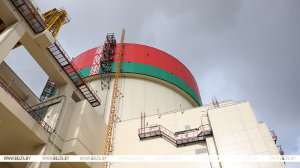Ru
|
Eng
Belarusian nuclear power plant helps satisfy growing demand for electricity
06.06.2024

MOSCOW, 6 June (BelTA) – The growing demand for electricity gets satisfied thanks to the Belarusian nuclear power plant. Belarusian Energy Minister Viktor Karankevich made the statement during the roundtable session “The Union State: 25 years of integration - results and new challenges” at the St. Petersburg International Economic Forum, BelTA has learned.
Viktor Karankevich said: “Since the first unit was connected to the power grid, the Belarusian nuclear power plant has generated over 30 billion kilowatt-hours of electricity. At present the two units of the nuclear power plant operate at full capacity. The nuclear power plant satisfies the growing demand for electricity of the real sector of the economy and households. In 2023 the country’s total electricity consumption volume rose by 6.6% from 2022. Positive dynamics continued into 2024: electricity consumption increased by 9.7% in January-April.”
The official reminded that massive work to harmonize the legislation and improve the legal base has been completed in the sphere of nuclear energy together with Russian specialists for the sake of improving the safety and reliability of operation of the Belarusian nuclear power plant and technical support. “The Belarusian nuclear power plant has become the largest and most technologically advanced project in Belarusian-Russian cooperation. Thanks to the construction of the nuclear power plant our country has completely stopped importing electricity. Dependence on imported natural gas decreased. Peaceful nuclear energy guarantees not only energy sovereignty and stable development of the energy system but also gives a serious competitive edge to many allied branches of the economy: manufacturing sector, science, education, and healthcare,” the minister stressed.
“Joint work with our strategic partner – the state corporation Rosatom – continues both in the sphere of nuclear energy and in allied non-energy areas: additive technologies, energy accumulation systems, equipment simulation construction, and digitization,” Viktor Karankevich added.
BELNPP: NEWS FROM CONSTRUCTION SITE
23.07.2024
11.07.2024
28.06.2024
06.06.2024
04.06.2024
04.06.2024
03.06.2024
24.05.2024
23.05.2024
03.05.2024













